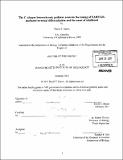| dc.contributor.advisor | H. Robert Horvitz. | en_US |
| dc.contributor.author | Harris, David T. (David Taylor) | en_US |
| dc.contributor.other | Massachusetts Institute of Technology. Dept. of Biology. | en_US |
| dc.date.accessioned | 2011-05-09T15:34:17Z | |
| dc.date.available | 2011-05-09T15:34:17Z | |
| dc.date.copyright | 2011 | en_US |
| dc.date.issued | 2011 | en_US |
| dc.identifier.uri | http://hdl.handle.net/1721.1/62779 | |
| dc.description | Thesis (Ph. D.)--Massachusetts Institute of Technology, Dept. of Biology, 2011. | en_US |
| dc.description | Cataloged from PDF version of thesis. | en_US |
| dc.description | Includes bibliographical references. | en_US |
| dc.description.abstract | Most animals pass through a series of juvenile stages on their way from embryo to adult. These stages represent periods of time in which stage-specific developmental processes occur. At the end of development, the organism transitions from a juvenile state to a mature adult. The failure to undergo a specific developmental stage, or the failure to transition to an adult can lead to specific developmental deficits or the retention of juvenile characteristics throughout the remainder of the organism's life. This thesis focuses on the study of the mechanisms controlling the larval-to-adult transition in C. elegans. In Chapter two, I perform a screen to identify mutants that are defective in a specific aspect of the larval-to-adult transition, exit from the molting cycle. From this screen I identify new alleles of the previously identified gene mab-10. I then clone mab-10, showing that it encodes the only C. elegans NAB family transcriptional cofactor. I go on to show that MAB- 10 acts with LIN-29 to control the larval-to-adult transition and that LIN-29 shares homology with mammalian EGR proteins. These observations highlight the similarity between the mechanisms controlling the onset of adulthood in C. elegans and mammals as LIN-29 is required for the larval-to-adult transition in C elegans and EGRI is required for the onset of puberty in mice. Chapter three is a further analysis of both mab-10 and lin-29, focusing on their expression patterns and roles in the terminal differentiation of tissues outside of the hypoderm. We use a mab-10 translational reporter to show that MAB-10 accumulates precociously in precocious heterochronic mutants and that mab-10 transcription does not require lin-29, suggesting that the heterochronic pathway controls the timing of mab-10 transcription in parallel to lin-29. We use single molecule fluorescence in situ hybridization to establish the wild-type transcription patterns of mab-10 and lin-29 and show that both undergo dynamic changes in expression throughout development. We show that mab-10 is required for terminal differentiation in at least one other tissue outside of the hypoderm and that mab-10 prevents seam cell overproliferation by antagonizing the activities of the C. elegans Runx and CBF-Beta homologs rnt-1 and bro-1. | en_US |
| dc.description.statementofresponsibility | by David T. Harris. | en_US |
| dc.format.extent | 165 p. | en_US |
| dc.language.iso | eng | en_US |
| dc.publisher | Massachusetts Institute of Technology | en_US |
| dc.rights | M.I.T. theses are protected by
copyright. They may be viewed from this source for any purpose, but
reproduction or distribution in any format is prohibited without written
permission. See provided URL for inquiries about permission. | en_US |
| dc.rights.uri | http://dspace.mit.edu/handle/1721.1/7582 | en_US |
| dc.subject | Biology. | en_US |
| dc.title | The C. elegans heterochronic pathway controls the timing of NAB/EGR-mediated terminal differentiation and the onset of adulthood | en_US |
| dc.title.alternative | Caenorhabditis elegans heterochronic pathway controls the timing of NAB/EGR-mediated terminal differentiation and the onset of adulthood | en_US |
| dc.type | Thesis | en_US |
| dc.description.degree | Ph.D. | en_US |
| dc.contributor.department | Massachusetts Institute of Technology. Department of Biology | |
| dc.identifier.oclc | 719369525 | en_US |
